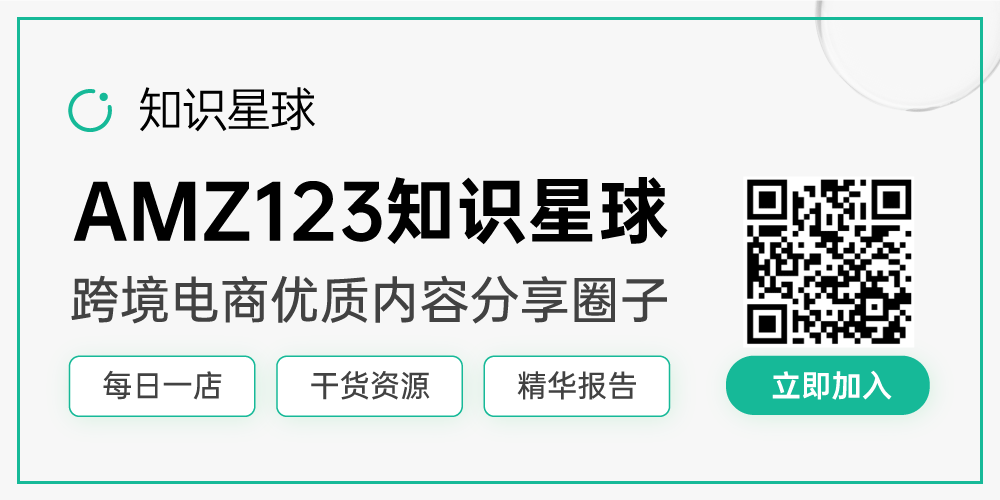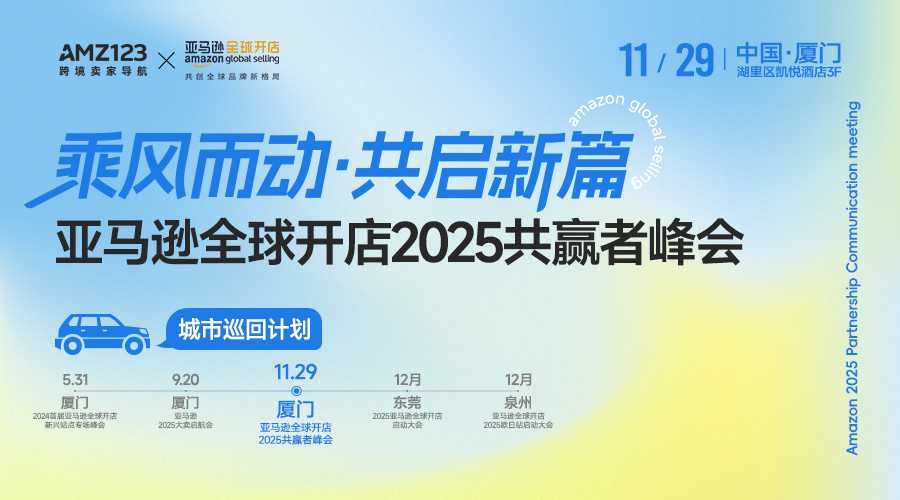注意!美国海关正式实施这项新规,违者面临严厉处罚!
走美线空运的货代、货主注意了!6月12日起,CBP的“ACAS计划”在结束了一年的宽限期后,将正式强制实施!在强制实施开始后,如有违反,可能会遭到CBP的处罚,带来经济损失、无法清关货物滞留等风险!
2018年6月12日,CBP发布了航空货物预先筛选计划,简称“ACAS”。该计划是美国海关(CBP)与运输安全管理局(TSA)为加强空运货物安全而制定的联合计划。
该计划要求国外承运人将进口至美国的货物(含在美国中转)信息,在货物装机前以电子数据方式传给美国CBP (美国海关及边防局)的ATS系统(Automated Targeting System)进行审查,以便识别进口货物的安全威胁风险。
Air Cargo Advance Screening (ACAS)
The Air Cargo Advance Screening (ACAS) Program went into effect on June 12, 2018, requiring the submission of advanced air cargo information on shipments arriving in the United States from a foreign location. Previously a voluntary process in which many airlines already participated globally, the program requirements are now mandatory for airlines flying to the United States. This is a necessary measure as the Department of Homeland Security (DHS) continues to raise the baseline on aviation security worldwide.
As part of the ACAS program, participating carriers submit a subset of required pre-arrival air cargo data to CBP at the earliest point practicable and prior to loading the cargo onto aircraft destined to or transiting through the United States.
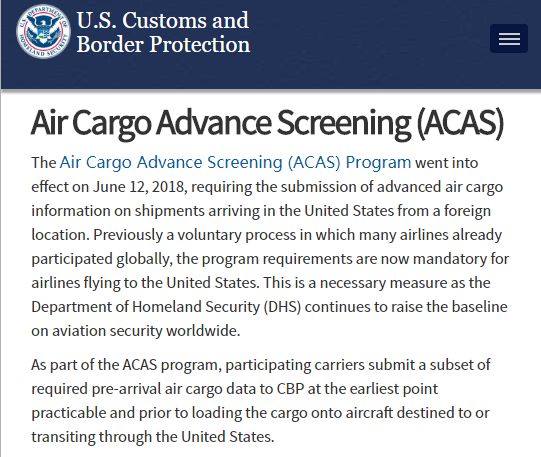
(CBP公告)
由于“ACAS计划”一年的宽限期已结束,目前已陆续有航空货运公司、货运代理公司发布通知提醒:
自2018年6月12日起由美国当局推出的"美国空运货物预先安检计划"(Air Cargo Advance Screening(ACAS)),在经过12个月调整宽限期后,将于今年2019年6月12日起开始正式全面实施。该系统由CBP(美国海关及边境保卫局)和TSA(美国运输安全管理局)联合推行,主要目的是增强航空货运的安全性。该计划要求所有飞往美国的货物均需在装载于飞往美国的航班(包括所有旅客航班及全货机航班)前取得搭载许可。
为了保证货物的顺利搭载,我司制定了以下流程,还望各位客户能够给予我们理解与配合。
具体要求:
1.实施开始日
2019年4月1日 出发前往美国的航班
2.对象货物
发往美国方向的所有货物
3.申请搭载许可流程
(1)航空公司以电子数据传输方式向美国当局发送货物的相关信息(FWB/FHL)。
(2)美国当局对货物信息进行审查,并将审查结果回复航空公司。
(3)航空公司对审查结果进行确认(※)
(4)确认该货物可搭载后,开始进行组板作业。
※根据规定未经审查的货物及审查不合格的货物不可搭载在航班上。
4.要求
(1)严格遵守电子数据提交时限(电子数据・AWB搬入)
※根据个别特殊情况,可能会需要客户的另行配合,还请知晓。
(2)保证提交数据的准确性
※如发生延迟提交货物信息或提交信息有错误时,该货物将无法搭载在原定航班上。
※必要的信息与目前通过CCSJ等传输的内容相同。
※关于货物品名,请申报具体的品名,而不是总称。
5.其他
(1)我司不会将货物的分舱单(HAWB)信息用于除运输外的其他用途。除受到有关当局的指示外,我司亦不会将该货物信息向包括当局在内的其他机构进行公开。
(2)提交电子信息所需费用,请垂询我司各销售部门负责人。
(3)由于货物信息不准确产生的海关罚金、退运费等一切费用将向代理公司征收,还望知悉。
(4)为了保证货物的顺利搭载,还烦请各位客户尽可能通过电子传输方式提供信息。
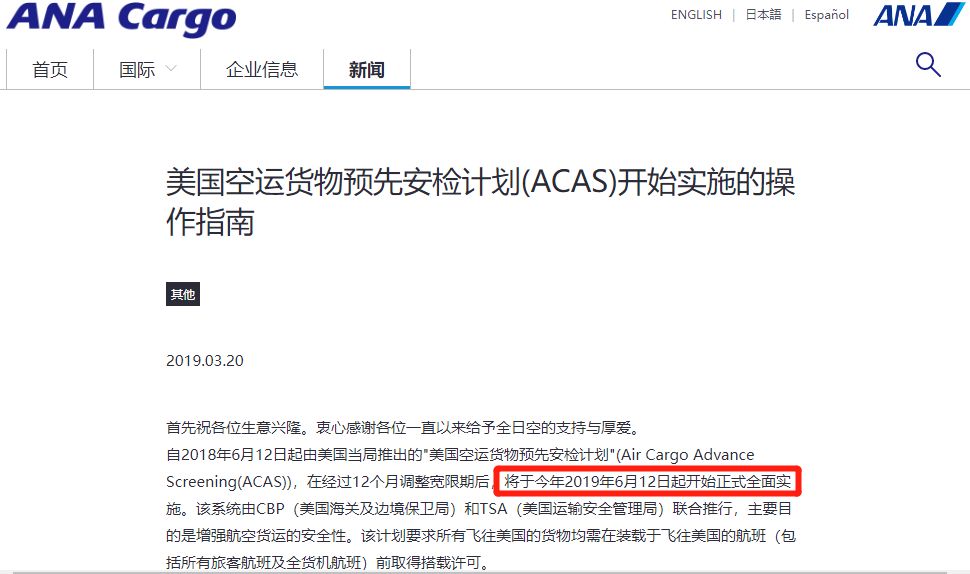
要求所有运往美国或途经美国的国际货物提前向ACAS提交数据。最后的规则要求在合并和将货物装上飞机之前及时提交ACAS数据。信息提交得越早,筛检或不加载(DNL)消息的速度就越快。
目前有几种归档ACAS的方法:1)航空公司可以单独归档AMS/ACAS,或者2)航空货代和承运人可以同时归档(各自归档)。
航空公司在提交单一航空公司文件的情况下,根据《贸易法》的要求,传送预先装运数据以供安全备案,同时随后传送离境后自动舱单系统(AMS)数据。航空公司在装货前将自动医疗辅助系统的资料传送给海关,并进行所有必要的检查。CBP将使用预加载AMS传输来满足ACAS和AMS的要求。
在货运代理/航空公司的双重备案文件中,货运代理可以直接向CBP发送室内航空货运单数据,以满足预装载目标和舱单要求。货代和承运人在合并和交付给航空承运人之前都收到ACAS响应。航空公司在确认成功传输ACAS后接受货代货物运输,并进行任何必要的筛选。
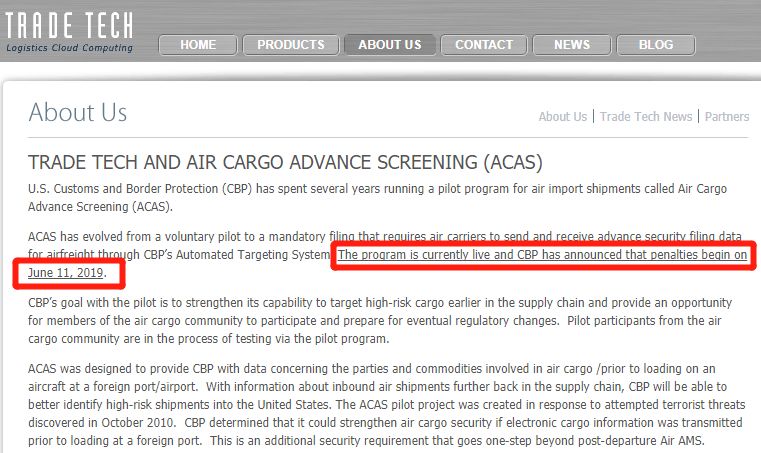
*空运提单号码(House Airway bill (AWB) Number)
*信息发件人
*托运人姓名和地址
*收货人姓名和地址
*重量(单位为磅或千克)
*件数
*货物描述(应避免通用货物描述)
请货代、货主根据要求,提前准备好货物相关信息,以免因为信息有误或者不充分导致无法上机货物延迟或者遭到CBP处罚。
附:空运货物预先筛检常见问题

Air Cargo Advance Screening
Frequently Asked Questions
Q: Why did the government implement the Air Cargo Advance Screening (ACAS) program and under what legal authority does it operate?
A: Following a terrorist attempt in October 2010 involving explosives concealed in U.S.-bound packages from Yemen, U.S. Customs and Border Protection (CBP) and the Transportation Security Administration (TSA) worked to enhance air cargo supply chain security by piloting ACAS to target shipments inbound to the United States. CBP’s legal authority is derived from the Trade Act of 2002; TSA’s legal authority comes from the Aviation Transportation Security Act.
Q: What are the benefits of the ACAS program?
A: Several universal advantages include:
Increased security by leveraging Department of Homeland Security (DHS) threat data and other data to employ a risk-based approach to improve air cargo security through targeted screening
Gained efficiencies by automating identification of high-risk cargo for enhanced screening before it is consolidated and loaded on U.S.-bound aircraft
Reduced paper processes related to cargo screening requirements, thereby increasing carrier convenience
Q: Who is required to submit ACAS data to CBP?
A: The inbound air carrier is required to file the ACAS data if no other eligible party elects to file. CBP is allowing parties other than the inbound air carrier to file because in some cases, these other parties will have access to accurate ACAS data sooner. For effective targeting to occur prior to loading, it is essential that the most accurate ACAS data be filed at the earliest point possible in the supply chain. This approach is consistent with parameters in the Trade Act of 2002 that require CBP to obtain data from the party most likely to have direct knowledge of the data and to balance the impact on the flow of commerce with the impact on cargo safety and security.
Q: Who do I contact to begin sending ACAS data?
A: All parties required to or interested in transmitting ACAS data should contact their assigned CBP Client Representative. If one has not yet been assigned, please send an e-mail to gmb.clientrepoutreach@cbp.dhs.gov.
Q: What type of data do I need to submit, and how should the data be submitted?
A: The ACAS data elements are a subset of the data required pursuant to section 343(a) of the Trade Act of 2002:
Shipper name and address
Consignee name and address
Cargo description
Piece count
Weight
Air waybill number
Airlines and freight forwarders exchange advance security filing data and related action messages for air cargo with CBP using new messages modeled on either existing Cargo-IMP format messages or CBP CAMIR-Air messages. While the overall form of the ACAS message is similar to the message on which it is based, the new message formats have slight differences in edits, timing, or new coded values as needed. CBP has developed an ACAS Implementation Guide, but for quick reference, the messages used for ACAS are as follows:
Optional ACAS Message Format | Based On | Source |
PHL | FHL | Cargo IMP |
PRI | FRI | CAMIR Air |
PSN | FSN | CAMIR Air |
PER | FER | CAMIR Air |
PWB | FWB | Cargo IMP |
Q: How far in advance does ACAS data have to be submitted?
A: ACAS data should be transmitted prior to consolidation and loading the cargo on an aircraft. This timeline is required to enable risk assessment for each cargo shipment and to conduct the required screening. The sooner data are submitted to ACAS, the sooner screening or Do Not Load (DNL) determinations can be communicated to industry stakeholders, which minimizes the impact to operations.
Q: Are there penalties for incorrect or untimely ACAS data submission?
A: Yes, ACAS violations are subject to liquidated damages claims. However, CBP will be taking a common sense approach to enforcement, and will not generally be issuing liquidated damages claims for the first 12 months following the publication of the rule.
Q: Which government agencies have access to my organization’s ACAS data submissions?
A: CBP and TSA.
Q: What are the costs of participating in ACAS?
A: The government does not charge for ACAS participation. Organizations that use third-party service providers may find that those providers will charge for ACAS services.
Q: To what extent is the international community (for example, Border Action Plan, European Union, World Customs Organization) involved with ACAS, and how is the U.S. Government promoting uniformity of air cargo security programs globally?
A: A critical component to achieving a global solution to terrorism is international cooperation on data collection standards that promote a harmonized approach to international air cargo security. The United States sees ACAS as a model for the international community to effectively enhance air cargo security, and will continue to work with the World Customs Organization and the International Civil Aviation Organization as harmonization of air cargo security standards spread to all areas of the globe, further facilitating trade and enhancing security worldwide.
Q: What are the benefits of ACAS from a freight forwarder perspective?
A: While the benefits of ACAS participation vary between organizations, several advantages include:
Avoiding the reduced cut-off times that may result from carriers requesting earlier data submission from freight forwarders that are not ACAS filers
Facilitating freight forwarder business operations by increasing consolidation lead-times through improved visibility into which shipments require enhanced screening
Increasing security by leveraging DHS threat data and other data to employ a risk-based approach through targeted screening
Q: How would it work for a freight forwarder if a shipment requires enhanced screening?
A: Should a shipment require enhanced screening, email or phone notification will be provided to the freight forwarder as soon as possible, in order to afford the freight forwarder an opportunity to segregate or screen the shipment under its National Cargo Screening Program (NCSP), or as an authorized representative of the carrier, as appropriate. Where a freight forwarder is not able to perform the enhanced screening, the forwarder should communicate the ACAS disposition of the cargo to the carrier, and the carrier will perform the screening.
Q: How does ACAS apply in countries that have NCSP recognition through TSA?
A: ACAS is required for air cargo supply chain participants in all countries, including those operating under an NCSP. Operating in an NCSP country does not exempt participants from ACAS requirements; the NCSP program simply allows approved air cargo supply chain participants to screen in accordance with that country’s domestic cargo screening regime.
Q: What do I do if my data transmission is rejected?
A: Correct the error and resubmit. If you are not able to determine the issue, please contact your Client Representative.
Q: Who do I contact if I have technical issues?
A: Please contact your Client Representative. If one has not yet been assigned, please send an email to
gmb.clientrepoutreach@cbp.dhs.gov.
Q: What happens if there is a duplicate filing?
A: Subsequent filings are treated as updates by the ACAS system. Unlike the CAMIR, there is no need to distinguish between inbound messages (such as FRI) and change messages (such as FRC).
(文章来源:综合CBP官网、ANA Cargon、Trade Tech、运去哪,版权归原作者所有,本号旨在转载分享交流,不代表本号观点,不用作商业用途,如涉及版权等问题,请尽快于我们联系删除)






